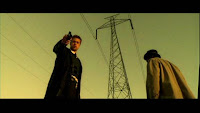PRODUCTION
Level 3 36–47 marks
There is evidence of proficiency in the creative use of many of the following technical skills:
Producing material appropriate for the target audience and task;
using titles appropriately according to institutional conventions;
using sound with images and editing appropriately for the task set;
shooting material appropriate to the task set;, including controlled use of the camera, attention to
framing, variety of shot distance and close attention to mise-en-scene;
using editing so that meaning is apparent to the viewer and making selective and appropriate use of
shot transitions and other effects.
Level 4 48–60 marks
There is evidence of excellence in the creative use of most of the following technical skills:
material appropriate for the target audience and task;
using titles appropriately according to institutional conventions;
using sound with images and editing appropriately for the task set;
shooting material appropriate to the task set;, including controlled use of the camera, attention to
framing, variety of shot distance and close attention to mise-en-scene;
using editing so that meaning is apparent to the viewer and making selective and appropriate use of
shot transitions and other effects.
RESEARCH AND PLANNING
Level 4 48–60 marks
There is evidence of excellence in the creative use of most of the following technical skills:
material appropriate for the target audience and task;
using titles appropriately according to institutional conventions;
using sound with images and editing appropriately for the task set;
shooting material appropriate to the task set;, including controlled use of the camera, attention to
framing, variety of shot distance and close attention to mise-en-scene;
using editing so that meaning is apparent to the viewer and making selective and appropriate use of
shot transitions and other effects.
Level 4 16–20 marks
Planning and research evidence will be complete and detailed;
There is excellent research into similar products and a potential target audience;
There is excellent organisation of actors, locations, costumes or props;
There is excellent work on shotlists, layouts, drafting, scripting or storyboarding;
There is an excellent level of care in the presentation of the research and planning;
Time management is excellent.
EVALUATION
Level 3 12–15 marks
Proficient skill in the use of digital technology or ICT in the evaluation.
Proficient understanding of issues around audience, institution, technology, representation, forms
and conventions in relation to production.
Proficient ability to refer to the choices made and outcomes.
Proficient understanding of their development from preliminary to full task.
Proficient ability to communicate.
Level 4 16–20 marks
Excellent skill in the use of appropriate digital technology or ICT in the evaluation.
Excellent understanding of issues around audience, institution, technology, representation, forms
and conventions in relation to production.
Excellent ability to refer to the choices made and outcomes.
Excellent understanding of their development from preliminary to full task.
Excellent ability to communicate.














